What is Google’s Selective Link Priority?
Selective Link Priority occurs when Google encounters multiple links on a page that target the same URL, typically with different anchor text. In this scenario, instead of using all the different anchor texts, Google is known to select only certain anchor texts for ranking purposes.
While sometimes known as “First Link Priority,” Google may select links other than the first.
An Introduction to Link Priority
SEOs know that links are hugely important to Google.
But Google does not treat all links equally.
For example, consider how Google responds when you include multiple links on a page, all pointing to the same URL. Does Google pass all signals through each link the same?
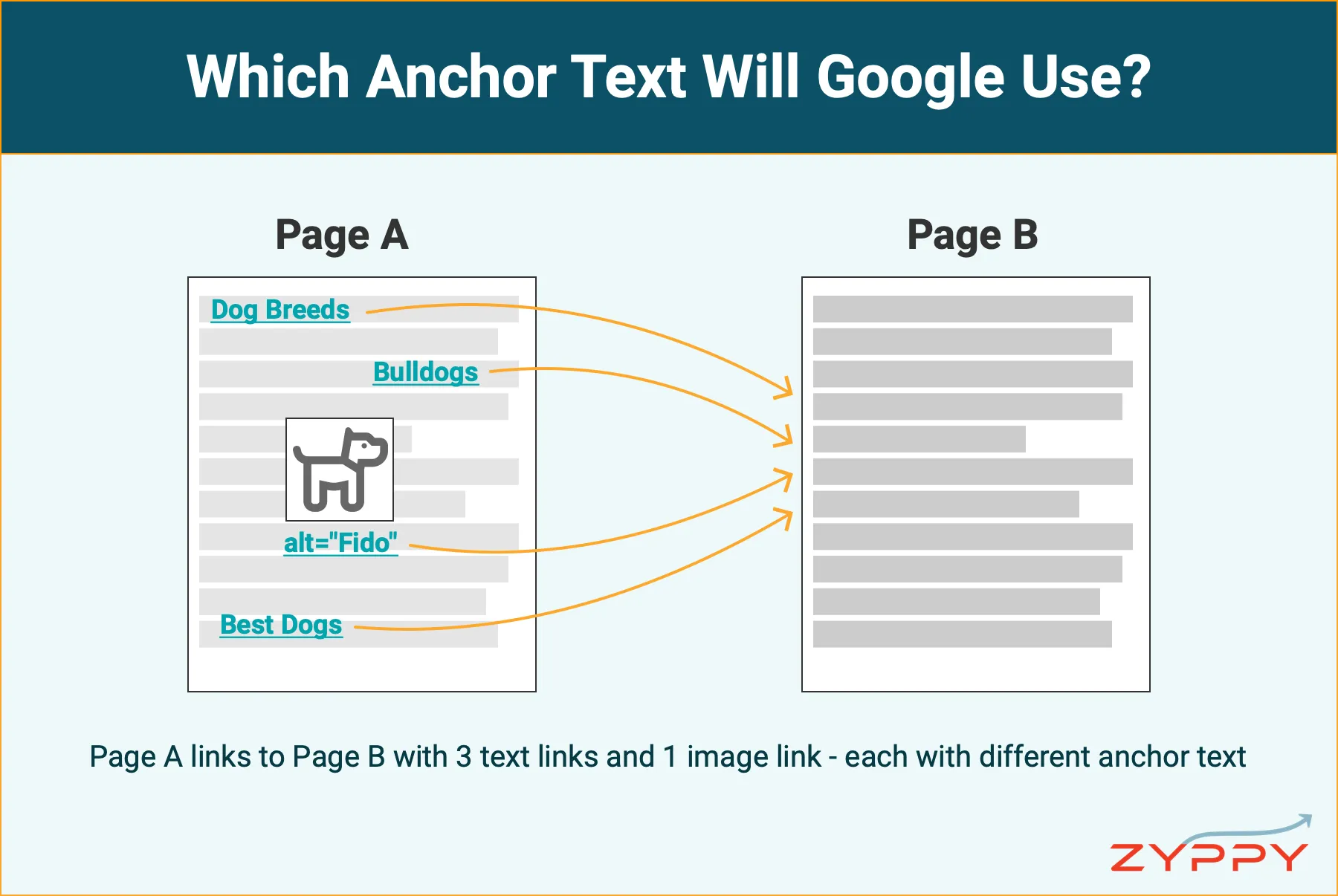
In the past, SEOs understood that when Google encountered many links on a page all pointing to the same URL, they passed stronger ranking signals through the first link. Specifically, only the first text link would pass anchor text signals.
This was known as First Link Priority.
To our knowledge, nobody in the SEO industry has published any testing on this in a long time. In the meantime, Google made several changes that made testing more difficult for SEOs and also potentially changed how Link Priority may work.
Let’s start by understanding how Google’s Link Priority historically worked, as explained by Google and past SEO experiments.
Why Does Google’s Link Priority Matter to SEO?
Out of 100s of potential signals Google uses to rank webpages, links are arguably some of the most important. Google can use links in dozens of ways. The two main signals passed are PageRank and anchor text.
PageRank (which Google has updated several times) determines how important pages are by scoring the number and quality of links between pages. Within Link Priority, all links are eligible to pass PageRank.
Anchor Text can help search engines understand what a page is about. If you link to a page using the anchor text cat videos, this may help rank higher for “cat videos.”
Many SEOs understand the value of links but underestimate the value of anchor text. In our recent research study, we found that a greater number of anchor text variations within internal links was significantly correlated with higher rankings.
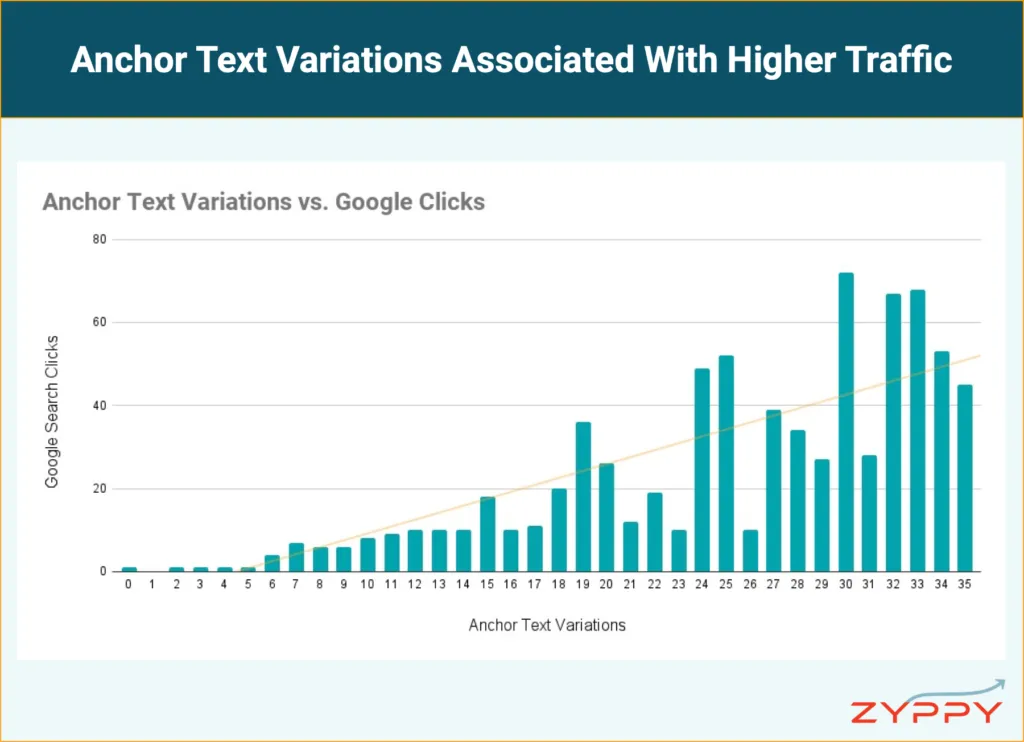
The number of anchor text variations a page has associated with higher rankings – much greater than even the total number of links. (Remember – correlation isn’t causation. Take things with a big grain of salt.)
Anchor text is a strong signal! Perhaps that’s why Google would want to limit it using processes such as Link Priority.
What is Selective Link Priority, And How Does it Work?
Back in 2014, Google engineer Matt Cutts explained how Link Priority worked in a YouTube video. (Bold added.)
Looking at the original PageRank paper, if you had two links from one page to another page, both links would flow PageRank… so it’s the case that if two links both go to the same page, then twice as much PageRank would go to that page…
I’ll go ahead and try to answer how anchor text might flow… we look at all the links on the page and we extract those. And then we annotate or affix them to the documents that they point to. And that link extraction process can select all the links, or it might just select one of the links, or it might just select some of the links. And that behavior changes over time. So the last time I checked was 2009. And back then we might, for example, only have selected one of the links from a given page.
– Matt Cutts
Over the years, multiple SEOs tested Google’s link priority rules. They found that when a page linked to the same page more than once, Google only counted the first anchor text.
An exception to this rule was when the first link was an image. In this case, Google counted both the image alt text AND the anchor text of the first text link.
In 2018, Google’s John Mueller updated Google’s stance on link priority in a Webmaster hangout:
“This isn’t something we have defined, where we say ‘It’s always like this — it’s always the first link, always the last link, always an average of the links, or something like that…
… that can change and it’s not something we have defined. So even if you manage to figure out how we currently do it today, then that’s not necessarily how we’ll do it tomorrow, or how it always is across all websites.
Rather, that’s something that our algorithms might choose to do one way or the other.”
– John Mueller
Mueller seems to confirm that Google doesn’t always count all the anchor text on a page but cautions against assuming it’s always the first link that Google uses.
Since Google may choose to only count certain anchor text on a page (and not necessarily the first one), we call this Google’s Selective Link Priority.
And we tested it!
Results From Selective Link Priority Experiments
In the past, SEOs tested link priority rules by “Google Bombing” a page, e.g., linking to a page using made-up words appearing nowhere else on the internet, and see if the target page ranked for that term.
Google eventually changed how Google bombing worked, so it became nearly ineffective in testing anchor text for SEO.
So we had to get creative.
To test link priority, we used Google Search Console’s Top Linking Text Report. Here’s how it works:
- Create a property in Search Console containing only pages not linked anywhere on the internet (this is important)
- Link to those pages from another site/page using specific anchor text
- Use the Top Linking Text report to see exactly which anchor text Google indexed and which ones they likely ignored
Let’s explore how each experiment played out.
Test #1: Image, Text (Control)
In our first text, we simply linked twice to the same URL from the same page. In this case, the first link was an image link (in which case the alt text counts as anchor text.) The second link was a text link with different anchor text pointing to the same page.
It took several weeks for Google to update the Top Linking Text report. When they finally did, we were able to confirm that Google did indeed count both anchor texts.
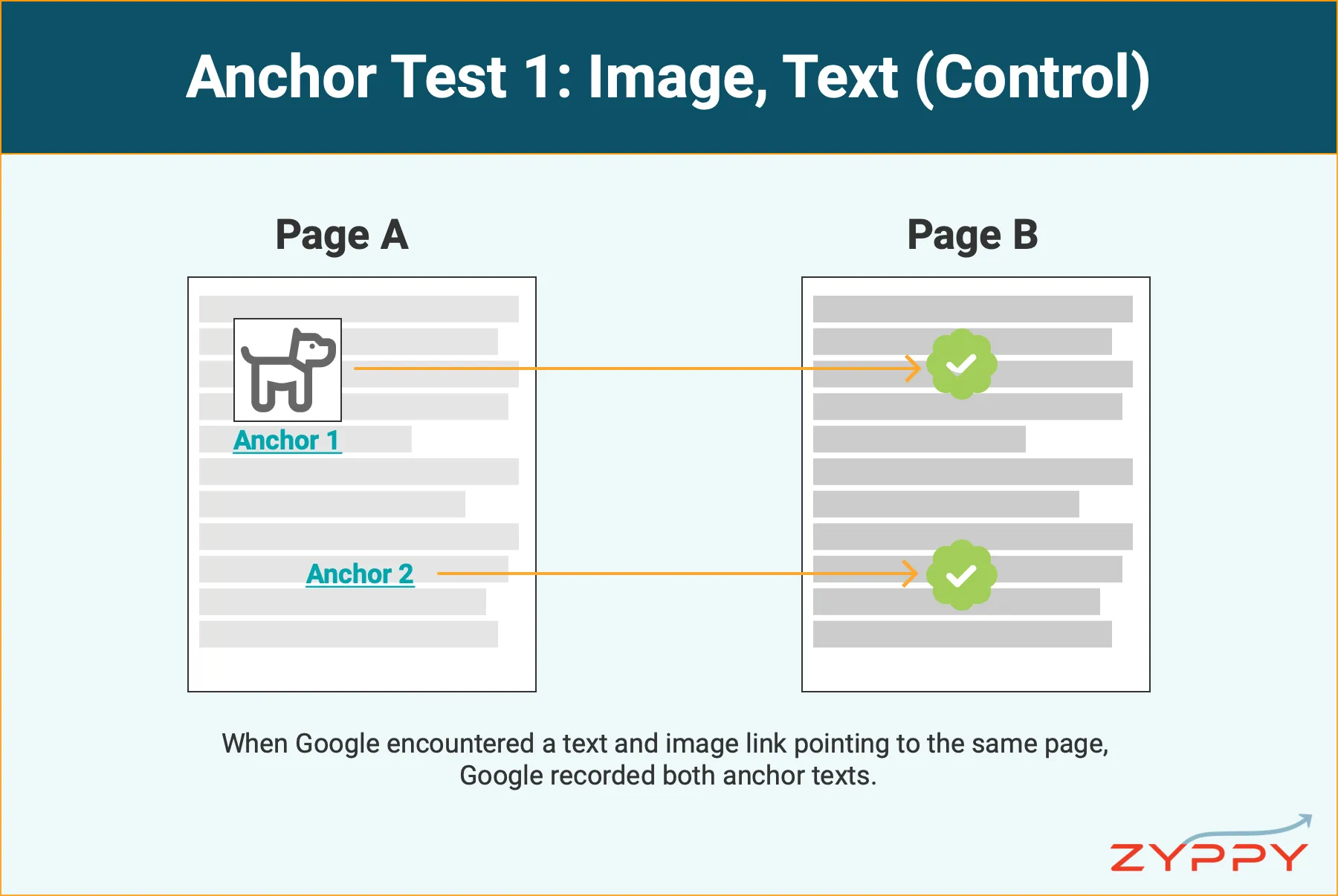
In this case, Google counted both anchor texts on the page to the same target, which included an image link and a text link below it.
Test #1 Takeaway: Google seems to be able to count multiple anchor texts on the same page to the same target, at least if one of the links is an image.
Test #2: Text, Text, Image
In this text, we set up two text links followed by an image link to the same target, all with different anchor text.
As expected, Google Search Console recorded the first anchor text. It did not report the second anchor text (text link.) Surprisingly, it also reported the image link, despite it being last on the page.
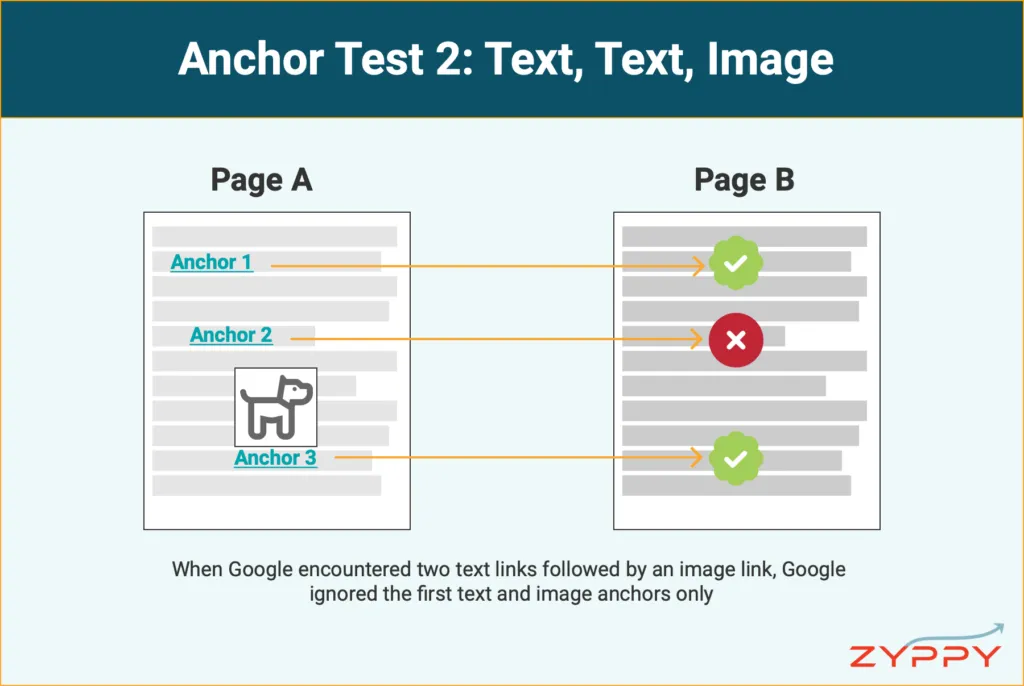
The fact that Google apparently ignored the second anchor text seems to confirm Google’s Selective Link Priority rule. In this case, they also picked to only count the first text link on the page, which matches historical precedent.
Surprisingly, Google also indexed the image link even though it was the last link on the page. This differs from our understanding of all previous link priority tests from years back. You could speculate that Google will index the first image anchor text it finds, no matter where it falls on the page.
Test #2 Takeaway: When Google encountered two text links followed by an image link, Google indexed the first text and image anchors only.
Test #3: Text, Text, Image, Text
Time to get more complex.
Test #3 mirrored earlier experiments, but this time we followed two consecutive text links with an image link, followed by a final text link. This means four links to the target page in total, all with different anchor text.
Based on earlier tests, we predicted Google would index the first text link and the first image link while ignoring the rest.
And indeed, that’s exactly what happened.
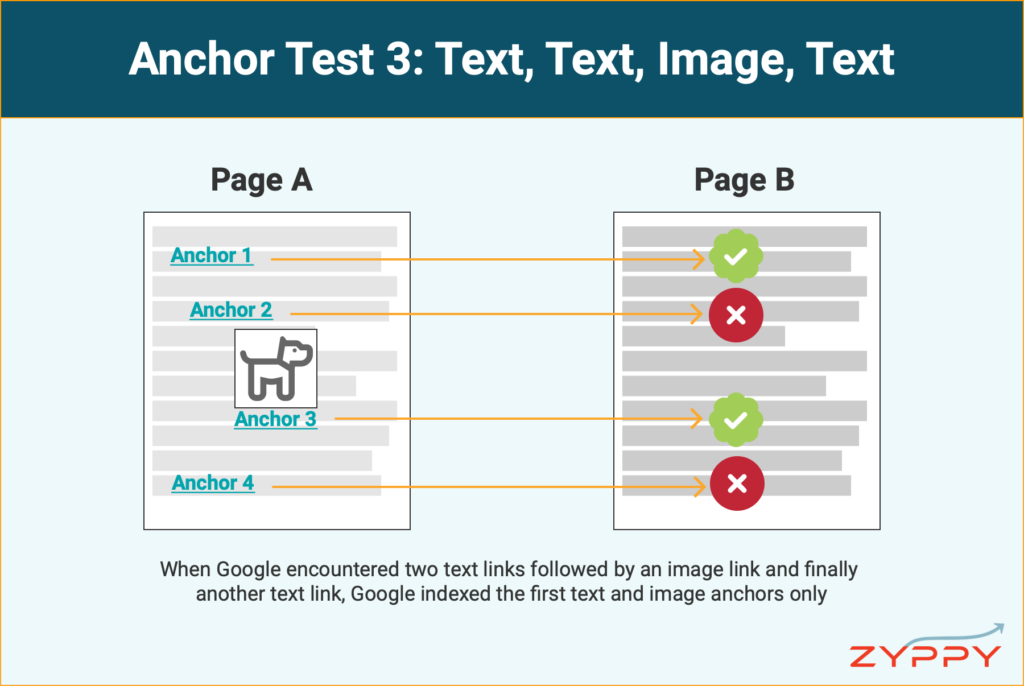
Again, this appears to confirm Google’s Selective Link Priority rule. In this instance, both the first text and image anchor text were recorded, while other anchors were ignored.
Test #3 Takeaway: When Google encountered two text links followed by an image link and finally another text link, Google indexed the first text and image anchors only.
Caveats: What We Don’t Know About Selective Link Priority
Google always cautioned SEOs about putting too much faith in “First Link Priority.” This is why we believe “Selective Link Priority” is a smarter way to consider anchor text indexing.
When multiple links all link to the same target URL, Google may record 1-2 anchor texts, but in our testing, they never reported more than that.
That said, it’s important to note that there may be many instances where Google doesn’t choose the first anchor text or the first image link. While we didn’t uncover any of these scenarios in testing, Google has always maintained this is possible, and they can change the anchors they index at any time.
Here are a few theoretical examples where Google might not choose the first anchor or image anchor:
- A link appears in both the navigation and the main text below. Google may prioritize the body link over the nav link.
- An image or text link contains empty anchor text. Google may ignore these in favor of links with actual anchor text.
- Google doesn’t fully render the page (because of JavaScript or some other reason.) In this case, Google would likely count the anchor text that was actually rendered despite its position on the page.
- Consider a logo image that links to the homepage from every page on the site. If another link on the page is linked to the homepage, Google could deprioritize the logo link.
While we don’t know exactly how Google will prioritize anchor text in any given situation, we do know they never seem to choose more than one text link and one image link – and it’s often the first link on the page.
What does this mean for your SEO?
How to Optimize For Google’s Selective Link Priority
Let’s be clear: Selective Link Priority most likely isn’t going to make a huge difference in your SEO strategy, but it can make a difference, especially in tie-breaker situations.
In particular, here are five internal linking practices in a Selective Link Priority world:
- Be aware when linking on a page multiple times to the same URL that Google may not “count” all of your anchor text.
- When in doubt, you should likely prioritize both the first text link and image links on the page.
- Remember that each link to a URL—regardless of anchor text—has the potential to increase that URL’s PageRank.
- Don’t leave image alt attributes empty, and remember to vary them from any text link anchors. Not only can Google index the alt attribute as a separate anchor, but this gives you the chance to further increase your anchor text variations.
- Sites with smaller external link profiles may wish to limit the number of navigational links in preference of in-body text links. The reason is that if Google does indeed tend to prefer the first links on the page—and these are navigational—this limits the number of anchor text variations you can send to any page. (This isn’t a hard-and-fast rule. In fact, it’s a nuanced, complex subject that may warrant a whole other post.)
The most important thing to remember is this – anchor text is a powerful ranking signal, even for internal links. Carefully choosing your anchor text—while avoiding over-optimization—can make a difference in winning SEO.
If your SEO game is otherwise strong, you may be able to get away with ignoring Google’s Selective Link Priority rules (as most sites do already.) But you should at least be aware of how it works and what it means to your strategy.
Addendum
A few folks in the SEO industry have experimented with techniques to circumvent Google’s Selective Link Priority in order to get more anchor texts indexed.
We have conducted our own experiments.
Watch this space for updates.

